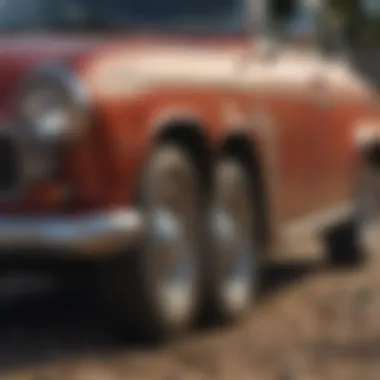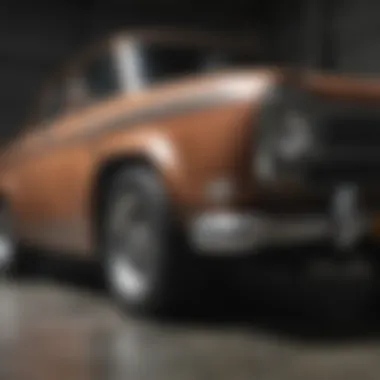Expert Tips for Choosing the Perfect Buffing Compound for Your Car


Introduction to Selecting the Best Buffing Compound for Cars
In the realm of car maintenance and detailing, the choice of buffing compound plays a significant role in achieving that coveted pristine finish. When navigating the plethora of options available, it is crucial to understand the nuances that dictate the suitability of a buffing compound for your specific requirements. By delving into the types of buffing compounds and mastering the art of application techniques, both car enthusiasts and detailing professionals can elevate their car care routine to a whole new level of excellence.
Exploring Different Types of Buffing Compounds
Before delving into the realm of buffing compounds, it is essential to grasp the distinct categories available in the market. Understanding the differences between abrasive compounds, finishing compounds, and all-in-one compounds is paramount in making an informed decision. Each type harbors unique properties and is tailored for specific stages of the buffing process.
Navigating Application Techniques Like a Pro
While selecting the ideal buffing compound sets the foundation for a successful detailing session, the application technique employed can make or break the final results. From the choice of buffing pad to the speed of the polisher, mastering these application nuances is key to unlocking the full potential of the selected compound. This section will delve into the intricacies of buffing compound application, offering valuable tips to streamline the process and achieve professional-grade results.
Closing Thoughts
As we journey through the realm of buffing compounds for cars, it becomes evident that the selection process goes beyond mere product choices. It is a convergence of science, technique, and artistry, driving enthusiasts and professionals alike to strive for automotive excellence. By honing our understanding of buffing compounds and perfecting our application prowess, we bring forth a new era of car care, where every detail shines with brilliance and sophistication.
Introduction to Buffing Compounds
In the realm of car detailing, understanding the nuances of buffing compounds is paramount. Buffing compounds play a crucial role in enhancing the aesthetic appeal of vehicles by removing imperfections and restoring shine. This section will delve into the fundamentals of buffing compounds, shedding light on their significance in the process of car maintenance and detailing. Choosing the right buffing compound can make a world of difference in achieving a flawless finish, making it a key aspect to consider for both enthusiasts and professionals alike.
What Are Buffing Compounds?
Buffing compounds are abrasive formulations designed to refine surfaces by removing blemishes, scratches, and oxidation. These compounds typically consist of micro-sized abrasive particles suspended in a compound base. The primary function of buffing compounds is to restore the gloss and smoothness of painted surfaces, making them indispensable in the automotive detailing industry.


Types of Buffing Compounds
Oxide Compounds
Oxide compounds are revered for their ability to tackle moderate imperfections such as swirl marks and light to moderate scratches on automotive paintwork. Their formulation often includes aluminum oxide or cerium oxide, providing effective cutting power without being overly aggressive. The key characteristic of oxide compounds lies in their balanced abrasiveness, making them a popular choice for enthusiasts looking to achieve a harmonious blend of cutting and finishing capabilities.
Emulsion Compounds
Emulsion compounds feature a unique blend of abrasive particles dispersed in a water-based emulsion. These compounds are known for their versatility, offering a good balance between cutting and finishing properties. An advantageous feature of emulsion compounds is their ease of use and user-friendly application, making them a preferred option for those seeking efficiency and convenience in buffing procedures.
Abrasive Compounds
Abrasive compounds are formulated with precision-ground abrasive particles that excel in correcting deep scratches, heavy oxidation, and tough surface imperfections. Their high cutting power makes them ideal for addressing severe paint defects, ensuring a thorough restoration process. Despite their effectiveness, abrasive compounds require skillful application to prevent overcorrection or damage to the paint surface, emphasizing the importance of technique and experience in utilizing these potent compounds.
Factors to Consider When Choosing a Buffing Compound
Paint Type and Condition
When evaluating the paint type and condition of your car, consider whether it has a clear coat finish or a single-stage paint. Clear coat finishes are more common in modern vehicles and provide an extra layer of protection over the base coat. Different buffing compounds are designed to work specifically with clear coats or single-stage paints, so understanding the distinction is crucial. Additionally, assess the condition of the paint by inspecting it for any swirl marks, scratches, oxidation, or fading. Each of these imperfections may require a different level of abrasiveness in the buffing compound to address effectively. Prioritize selecting a compound that aligns with the paint type and addresses any existing issues to achieve the best results.
Level of Abrasiveness
A key consideration when choosing a buffing compound is its level of abrasiveness. Buffing compounds come in varying degrees of abrasiveness, ranging from mild to highly abrasive. The level of abrasiveness required depends on the extent of imperfections present on the paintwork. For minor swirl marks or light scratches, a less abrasive compound may suffice, whereas deeper scratches or heavy oxidation may necessitate a more abrasive formula. It is essential to match the abrasiveness of the compound to the severity of the imperfections to avoid causing further damage to the paint. Additionally, consider the hardness of the clear coat when selecting an abrasive compound to ensure compatibility and prevent unintended harm to the paint.
Ease of Application


In addition to considering the paint type and abrasiveness level, evaluating the ease of application of a buffing compound is vital for achieving a satisfying polishing experience. Factors such as the consistency of the compound, its drying time, and the ease of removal play a significant role in the application process. Choose a buffing compound that is user-friendly and allows for smooth application without excessive effort. Additionally, opt for products that are easy to wipe off after buffing to minimize residue and streamline the overall process. Ensuring a hassle-free application will not only save time but also contribute to a more enjoyable detailing experience.
Environmental Considerations
Environmental factors can also influence the selection of a buffing compound for your car. Consider whether you will be working in an indoor or outdoor setting, as some compounds are better suited for specific environmental conditions. For instance, certain compounds may require controlled temperatures or humidity levels for optimal performance, making them more suitable for indoor use. Additionally, take into account any environmental regulations or restrictions in your area that may impact the use of certain compounds. Choosing a buffing compound that aligns with the environmental conditions of your workspace will help ensure smooth and effective application, contributing to a successful detailing process.
Popular Brands and Products
When it comes to selecting the best buffing compound for cars, paying attention to popular brands and products is crucial. Leading brands offer a wide array of compounds that cater to various needs and preferences of car enthusiasts and professionals. The reputation of a brand often reflects the quality and performance of its products, making popular choices a safe bet for achieving desirable results.
Popular brands such as Meguiar's, Chemical Guys, 3M, and Menzerna are renowned for their exceptional buffing compounds that deliver excellent outcomes. These brands have established themselves in the market due to their consistent quality, innovative formulations, and reliable performance. Choosing a buffing compound from a reputable brand ensures superior finish, ease of use, and overall customer satisfaction.
Factors to consider when evaluating popular brands and products include customer reviews, product ratings, ingredient transparency, and compatibility with different paint types. By conducting thorough research and considering individual requirements, selecting a buffing compound from a well-known brand becomes a strategic decision that can greatly enhance the detailing process.
Application Techniques for Buffing Compounds
In this section on Application Techniques for Buffing Compounds, we delve into the crucial aspect of applying buffing compounds to achieve optimal results in car detailing. Proper application techniques are fundamental to ensuring a flawless finish and enhancing the overall appearance of the vehicle. By understanding and mastering the application process, enthusiasts and professionals can elevate the detailing experience.
When it comes to applying buffing compounds, there are specific elements that demand attention. Firstly, the choice of applicators such as foam pads, microfiber cloths, or rotary buffers plays a significant role in the effectiveness of the application. Different surfaces may require varying applicators for the best results. Secondly, the correct amount of compound to be applied is crucial. Over-application can lead to wastage and potential damage, while under-application may result in uneven buffing.
Furthermore, the benefits of mastering application techniques are manifold. Proper application ensures that the compound is evenly spread, maximizing its abrasive properties for efficient paint correction. It also aids in achieving a uniform shine and finish across the entire surface of the vehicle. Moreover, utilizing the right technique can save time and effort, providing a more seamless buffing process.
Lastly, considerations about Application Techniques for Buffing Compounds include factors such as pressure exerted during application, the speed and direction of buffing motions, and the thoroughness of coverage on different sections of the vehicle. These considerations are instrumental in determining the final outcome of the buffing process and the level of gloss and protection attained.
Preparation of Surface


In the subsection focusing on the Preparation of Surface, attention is drawn to the critical preparatory steps that set the foundation for successful buffing. Preparing the surface of the car before applying the buffing compound is essential to ensure optimal results and prevent any potential damage to the vehicle's paintwork.
The preparation process typically involves thorough washing and drying of the vehicle to remove any surface contaminants such as dust, dirt, or residue. This initial step is crucial as it creates a clean canvas for the buffing compound to work effectively. Following this, inspection of the paint surface for imperfections, scratches, or swirl marks is necessary to determine the level of correction required.
Additionally, surface decontamination using detailing clay or iron fallout remover can further enhance the cleanliness of the paint surface, allowing the buffing compound to bond better and yield superior results. It is also recommended to mask off sensitive areas such as plastic trims or emblems to protect them from accidental damage during the buffing process.
By meticulously preparing the surface before buffing, enthusiasts and professionals can ensure a smoother and more efficient paint correction process, leading to a flawless finish and enhanced aesthetic appeal of the vehicle.
Buffing Procedure
Moving on to the Buffing Procedure, this section outlines the step-by-step process of buffing that enthusiasts and professionals should follow to achieve the desired results. The buffing procedure is a systematic approach that involves precise techniques and attention to detail to effectively correct imperfections and enhance the shine of the vehicle.
The buffing procedure typically starts with selecting the appropriate buffing compound based on the paint type and the level of correction required. It is essential to follow the manufacturer's recommendations regarding the application of the compound and the speed settings on the buffer to prevent potential damage to the paint surface.
Next, the actual buffing process involves working in small sections, applying the compound in a consistent manner, and using overlapping motions to ensure uniform coverage. Adjusting the pressure, speed, and angle of the buffer based on the working area is crucial for achieving optimal results. Regularly inspecting the surface for progress and making necessary adjustments throughout the buffing process is key to achieving a flawless finish.
Finally, completing the buffing procedure with a final pass using a finishing pad or cloth helps to refine the surface and enhance the gloss level. This step is essential for achieving a smooth and reflective finish that enhances the overall appearance of the vehicle.
Post-Application Care
In the Post-Application Care section, the focus shifts to the crucial steps that follow the buffing process to maintain and prolong the results achieved. Post-application care is essential for preserving the corrected paint surface, protecting it from environmental factors, and ensuring long-lasting shine and protection.
After buffing, it is recommended to thoroughly clean the surface to remove any residue left by the compound, ensuring a clean and pristine finish. Following this, the application of a high-quality carnauba wax or sealant helps to seal in the results, providing a protective layer that enhances the shine and durability of the paintwork.
Additionally, regular maintenance such as washing the vehicle with a p H-neutral shampoo, using a detailer spray for quick touch-ups, and avoiding exposure to harsh elements like direct sunlight or acidic contaminants, is crucial for preserving the buffed finish. Furthermore, periodic reapplication of wax or sealant extends the longevity of the shine and protection, keeping the vehicle looking its best.
By adhering to a proper post-application care routine, enthusiasts and professionals can ensure that the results of the buffing process are maintained long-term, preserving the aesthetic appeal and protective properties of the vehicle's paintwork.
Conclusion
In concluding this in-depth guide on selecting the best buffing compound for cars, it is imperative to emphasize the critical role that choosing the right compound plays in achieving a flawless finish for your vehicle. The quality of the buffing compound directly impacts the final outcome of the paint correction process, making it a crucial decision for both car enthusiasts and detailing professionals. By understanding the various types of buffing compounds available and considering factors such as paint type, level of abrasiveness, ease of application, and environmental impact, individuals can make informed choices that align with their specific needs and requirements. The selection of a suitable buffing compound ultimately determines the level of enhancement your car's surface will undergo, highlighting the significance of this decision-making process.







